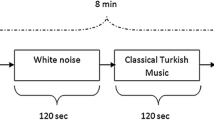Abstract
Purpose
The present study examined the relationships among cardiovascular autonomic, acoustic, and mood states in resting young subjects.
Methods
A total of 75 college students (men:women = 53:22), aged 19–24 years, were enrolled in this study. Each subject was asked to complete the profile of mood states and to produce a sustained vowel sound (/a/) for 3 s to calculate acoustic parameters. We calculated pulse rate variability (PRV) parameters such as low frequency (LF), high frequency (HF), total power (TP) and the ratio of low frequency to high frequency power (LF/HF) by analyzing peak-to-peak intervals detected by photoplethysmography.
Results
Sympathovagal balance-related parameters such as LF/HF were dominant indicators of fatigue in men and women, whereas LF and HF were indicative of depression and anger in women. In terms of acoustic parameters, shimmer and standard deviation of the fundamental frequency (SD F 0), which were related to roughness and instability in voice quality, were indicative of tension and depression in men and women.
Conclusions
The results of this study suggest that mood states in resting young subjects can be estimated from PRV and acoustic parameters.
Similar content being viewed by others
References
Sakuragi S, Sugiyama Y, Takeuchi K (2002) Effects of laughing and weeping on mood and heart rate variability. J Physiol Anthropol 21(3):159–165
Dishman RK, Nakamura Y, Garcia ME, Thompson RW, Dunn AL, Blair SN (2000) Heart rate variability, trait anxiety, and perceived stress among physically fit men and women. Int J Psychophysiol 37:121–133
Albert CM, Chae CU, Rexrode KM, Manson JE, Kawachi I (2005) Phobic anxiety and risk of coronary heart disease and sudden cardiac death among women. Circulation 111:480–487
Eaker ED, Sullivan LM, Kelly-Hayes M, D’Agostino RB, Benjamin EJ (2005) Tension and anxiety and the prediction of the 10-year incidence of coronary heart disease, atrial fibrillation, and total mortality: the Framingham offspring study. Psychosom Med 67:692–696
Carney RM, Blumenthal JA, Stein PK, Watkins L, Catellier D, Berkman LF, Czajkowski SM, O’Connor C, Stone PH, Freedland KE (2001) Depression, heart rate variability, and acute myocardial infarction. Circulation 104:2024–2028
Hayano J, Sakakibara Y, Yamada A, Yamada M, Mukai S, Fujinami T, Yokoyama K, Watanabe Y, Takata K (1991) Accuracy of assessment of cardiac vagal tone by heart rate variability in normal subjects. Am J Cardiol 67(2):199–204
Task Force of the European Society of Cardiology, the North American Society of Pacing, Electrophysiology (1996) Heart rate variability: standards of measurement, physiological interpretation, and clinical use. Eur Heart J 17:354–381
Selvaraj N, Jaryal A, Santhosh J, Deepak KK, Anand S (2008) Assessment of heart rate variability derived finger-tip photoplethysmography as compared to electrocardiography. J Med Eng Technol 32(6):479–484
Protopapas A, Lieberman P (1997) Fundamental frequency of phonation and perceived emotional stress. J Acoust Soc Am 101(4):2267–2277
Zupan B, Neumann D, Babbage DR, Willer B (2009) The importance of vocal affect to bimodal processing of emotion: Implications for individuals with traumatic brain injury. J Commun Disord 42:1–17
Mendozza E, Carballo G (1998) Acoustic analysis of induced vocal stress by means of cognitive workload tasks. J Voice 12:263–273
Johnstone T, Van Reekum CM, Bänziger T, Hird K, Kirsner K, Scherer KR (2007) The effects of difficulty and gain versus loss on vocal physiology and acoustics. Psychophysiology 44:827–837
Scherer K (1995) Expression of emotion in voice and music. J Voice 3:235–248
Smits I, Ceuppens P, De Bodt MS (2005) A comparative study of acoustic voice measurements by means of Dr. Speech and Computerized Speech Lab. J Voice 19(2):187–196
McNair DM, Lorr M, Droppleman LF (1992) Profile of mood states manual (revision): educational and industrial testing service. San Diego, CA
Hatayama T, Kitamura S, Tamura C, Nagano M, Ohnuki K (2008) The facial massage reduced anxiety and negative mood status, and increased sympathetic nervous activity. Biomed Res 29(6):317–320
Yu BH, Kang EH, Ziegler MG, Mills PJ, Dimsdale JF (2008) Mood states, sympathetic activity, and in vivo β-adrenergic receptor function in a normal population. Depress Anxiety 25:559–564
Nicollas R, Garrel R, Ouaknine M, Giovanni A, Nazarian B, Triglia JM (2008) Normal voice in children between 6 and 12 years of age: database and nonlinear analysis. J Voice 22:671–675
Fukusaki C, Kawakubo K, Yamamoto Y (2000) Assessment of the primary effect of aging on heart rate variability in humans. Clin Auton Res 10:123–130
Agelink MW, Boz C, Ullrich H, Andrich J (2002) Relationship between major depression and heart rate variability: clinical consequences and implications for antidepressive treatment. Psychiatry Res 113:139–140
Thayer JF, Brosschot JF (2005) Psychosomatics and psychopathology: looking up and lown from the brain. Psychoneuroendocrinology 30:1050–1058
Thayer JF, Friedman BH (2004) A neurovisceral integration model of health disparities in aging. In: Anderson NB, Bulato RA, Cohen B (eds) Critical perspectives on racial and ethnic differences in health in late life. The National Academies Press, Washington, pp 567–603
O’Conner PJ (2004) Evaluation of four highly cited energy and fatigue mood measures. J Psychosom Res 57:435–441
Naufel de Felippe AC, Grillo MH, Grechi TH (2006) Standardization of acoustic measures for normal voice patterns. Braz J Otorhinolaryngol 72(5):659–664
Ferrand CT (2002) Harmonics-to-noise ratio: an index of vocal aging. J Voice 16(4):480–487
Gorham-Rowan MM, Laures-Gore J (2006) Acoustic-perceptual correlates of voice quality in elderly men and women. J Commun Disord 39:171–184
Greeley HP, Berg J, Friets E, Wilson J, Greenough G, Picone J, Whitmore J, Nesthus T (2007) Fatigue estimation using voice analysis. Behav Res Methods 39(3):610–619
Puts DA, Hodges CR, Cardenas RA, Gaulin S (2007) Men’s voice as dominance signals: vocal fundamental and formant frequencies influence dominance attributions among men. Evol Hum Behav 28:340–344
Dabbs JM, Mallinger A (1999) High testosterone levels predict low voice pitch among men. Pers Individ Dif 27:801–804
Acknowledgments
This research was supported by the program of Kyung Hee University for the young researcher of medical science in KHU-20081259.
Author information
Authors and Affiliations
Corresponding author
Rights and permissions
About this article
Cite this article
Park, CK., Lee, S., Park, HJ. et al. Autonomic function, voice, and mood states. Clin Auton Res 21, 103–110 (2011). https://doi.org/10.1007/s10286-010-0095-1
Received:
Accepted:
Published:
Issue Date:
DOI: https://doi.org/10.1007/s10286-010-0095-1




